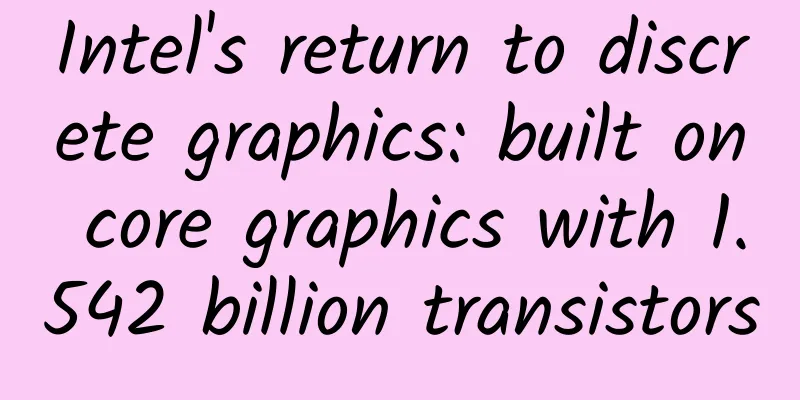Intel's return to discrete graphics: built on core graphics with 1.542 billion transistors

|
Intel occupies most of the world's graphics card market, but they are all based on their own integrated core graphics cards, which are barely usable. Historically, Intel has had two experiences with discrete graphics cards. The first was the 740 in 1998, the only discrete graphics card ever launched by Intel. The second was the Larrabee project from 2008 to 2010, which attempted to build an x86 architecture graphics card. However, it failed and the Xeon Phi accelerator project was successful.
Recently, Intel poached Raja Koduri, head of AMD's graphics card business, and appointed him as chief architect and senior vice president of the Core and Visual Computing Division. Its ambition to return to the independent graphics card market is obvious. At the ISSCC 2018 International Solid-State Circuits Conference held in San Francisco recently, Intel publicly disclosed for the first time the design ideas and prototypes of the new generation of independent graphics cards. Although they are only used for technical research and conceptual purposes, they can be regarded as an official announcement of the return of independent graphics cards. Intel did not provide any physical products this time, but only said that it has developed a GPU prototype chip and introduced some simple architecture and specifications. This GPU prototype chip is manufactured using Intel's 14nm process, has an area of 8×8 mm, and integrates 1.524 billion transistors. The architecture is based on Intel's current ninth-generation core graphics, but it is a low-voltage version Gen9LP on an ultra-low power platform. The basic internal structure is still EU computing units, totaling 18, divided into three groups, while integrating the system assistant (System Agent), including control system, IO, and even 4MB page cache. They are connected to the PC host through an FPGA bridge module and then through the PCI-E bus. As for future plans for discrete graphics cards, Intel will certainly not reveal anything, but AMD and NVIDIA have enough reasons to be highly alert.
As a winner of Toutiao's Qingyun Plan and Baijiahao's Bai+ Plan, the 2019 Baidu Digital Author of the Year, the Baijiahao's Most Popular Author in the Technology Field, the 2019 Sogou Technology and Culture Author, and the 2021 Baijiahao Quarterly Influential Creator, he has won many awards, including the 2013 Sohu Best Industry Media Person, the 2015 China New Media Entrepreneurship Competition Beijing Third Place, the 2015 Guangmang Experience Award, the 2015 China New Media Entrepreneurship Competition Finals Third Place, and the 2018 Baidu Dynamic Annual Powerful Celebrity. |
<<: iPhone 7 "No Service" Issue Can Be Repaired? Wishful Thinking
Recommend
A guide to avoiding pitfalls when placing ads on Weibo and WeChat!
There was an article that went viral this morning...
Rogue apps are eradicated from now on? Can unified push notifications save Android from disaster?
Recently, there is a piece of news that makes And...
The fighting power of "autumn mosquitoes" is off the charts. Let's have a "mosquito-killing" storm! See the "vicious" flowers
After finally getting through the summer mosquito...
Zhu Jun's personal information: Website promotion and optimization with a clear layout can bring a better experience to users
Website promotion and optimization with a clear l...
Is it true that there will be no Qingming Festival holiday in 2022? Why not take a holiday?
As the Qingming Festival approaches, the local ep...
Understanding "Content Marketing" in One Article
In which area have companies been increasing thei...
Experience 360 Video: A small but comprehensive video content platform
"360 Video has launched an APP, and all the c...
Are women's periods contagious? The truth may be different from what you think!
There are usually two reasons why menstruation ap...
The supply of double points is less than the demand in the first transaction. BYD makes more money selling points than selling cars.
As soon as the corporate dual-points calculation ...
"Intelligent Connected Vehicle Technology Roadmap 2.0" released! Juefei Technology takes the lead in realizing the large-scale implementation of the vehicle-road-cloud industry
Recently, the "2020 World Intelligent Connec...
Zhihu algorithm, ranking, increasing followers, traffic generation and practical skills
OK, before we talk about Zhihu algorithm , Q&...
Tip of the tongue phenomenon: Why can’t you remember the words that are on the tip of your tongue?
© The Lily Leviathan Press: We all have this expe...
I am so impressed by how information flow advertising is done!
After reading this article, I hope your informatio...
There was no college entrance examination in ancient times. Let’s talk about the history of the imperial examination for selecting talents in ancient times.
When it comes to "college entrance examinati...
GITC——Annual gathering of China's Internet technology elites
[[120838]] GITC 2014 Global Internet Technology C...









